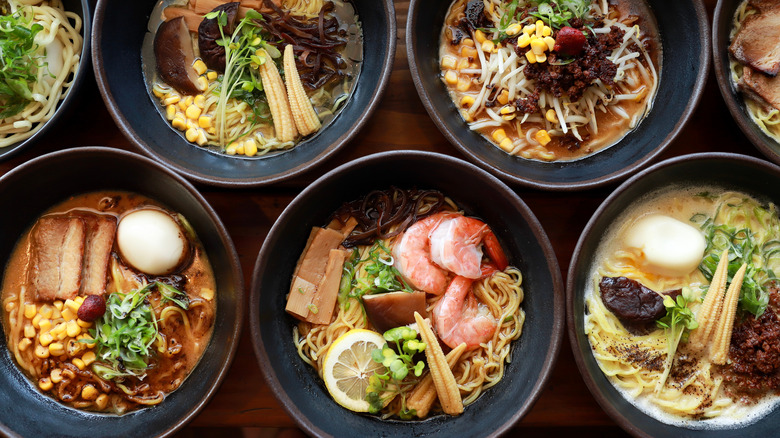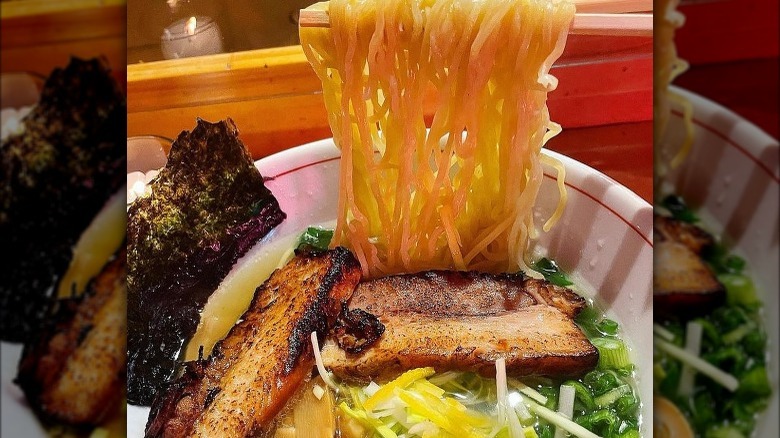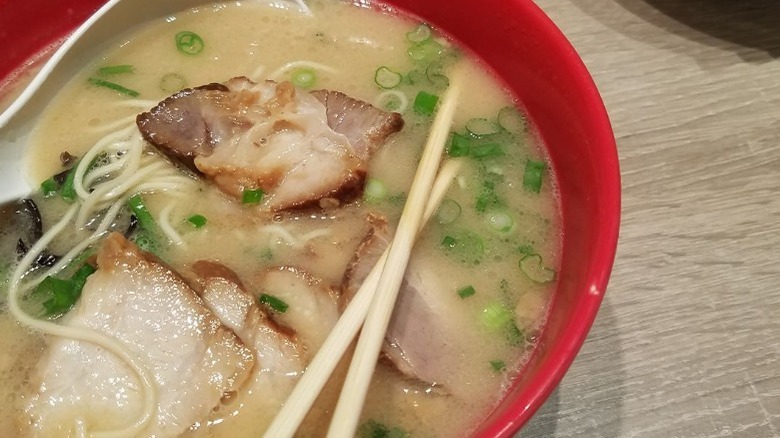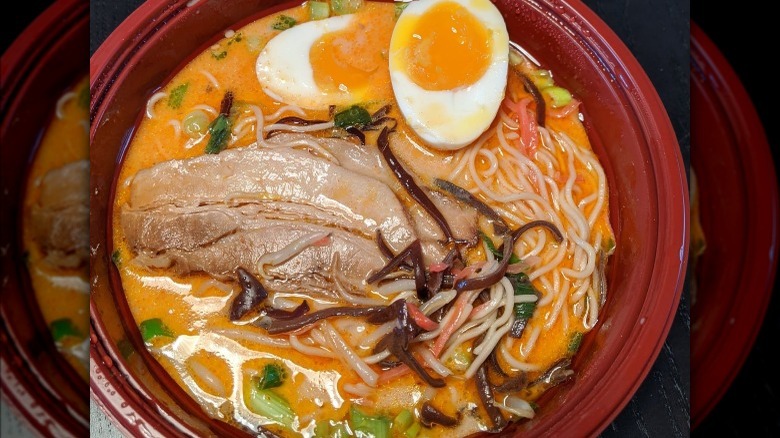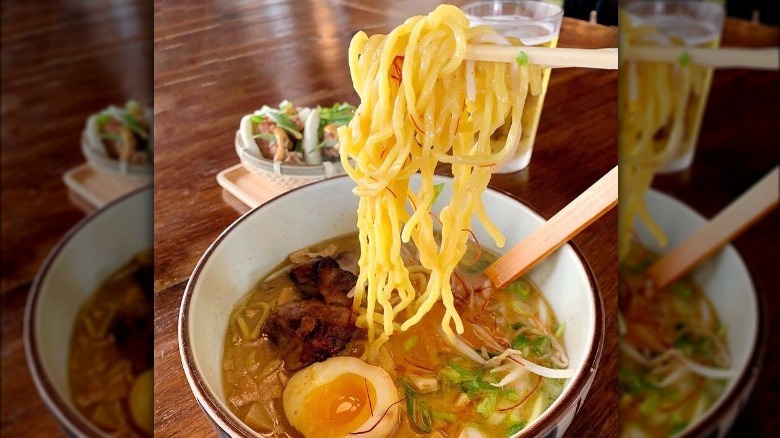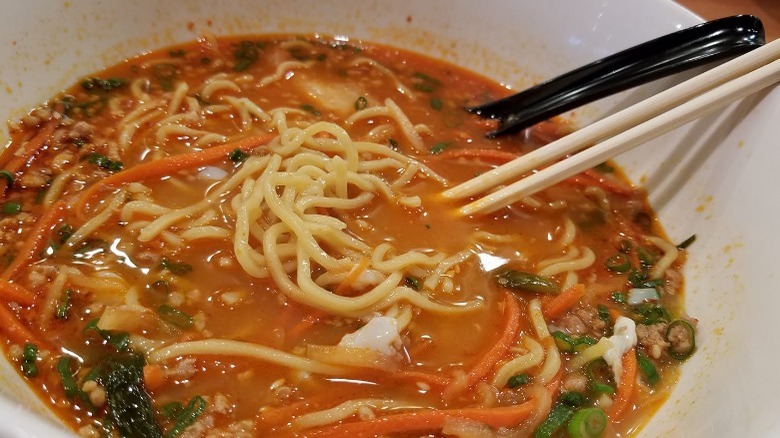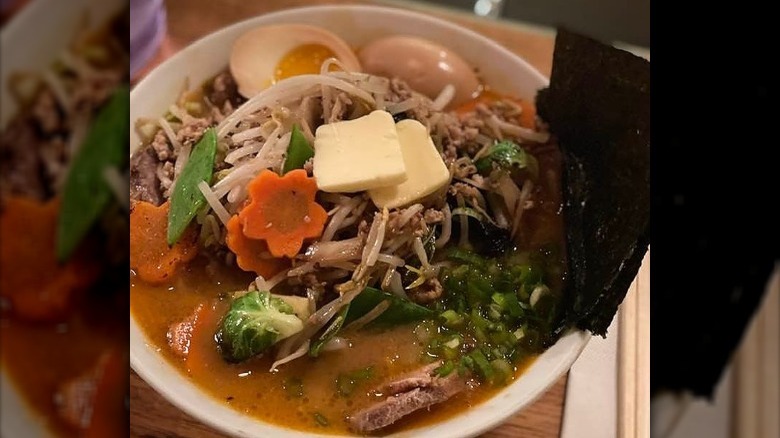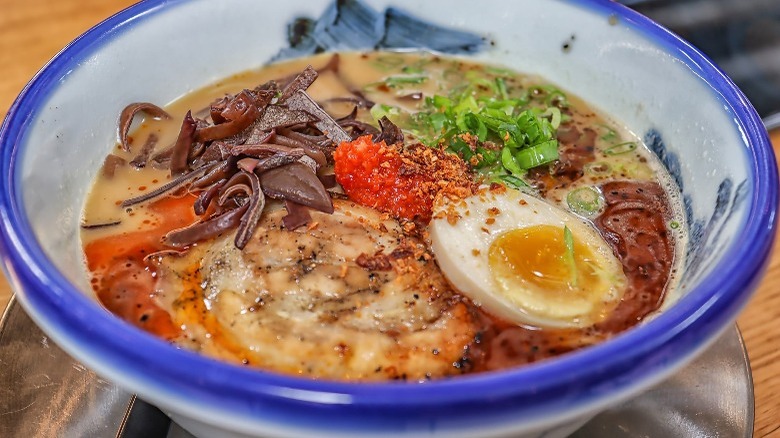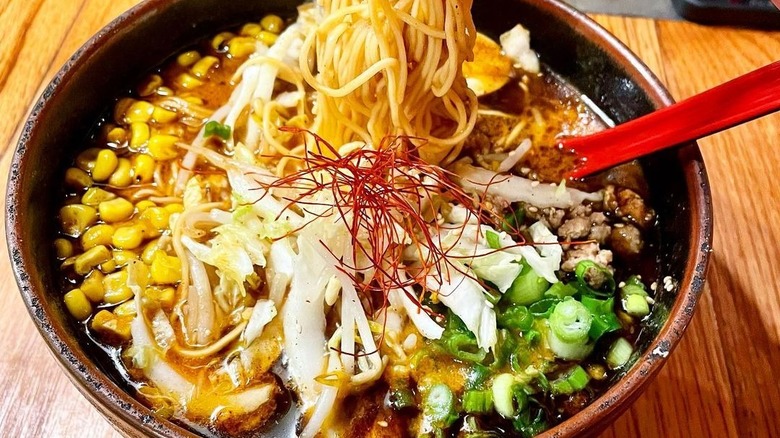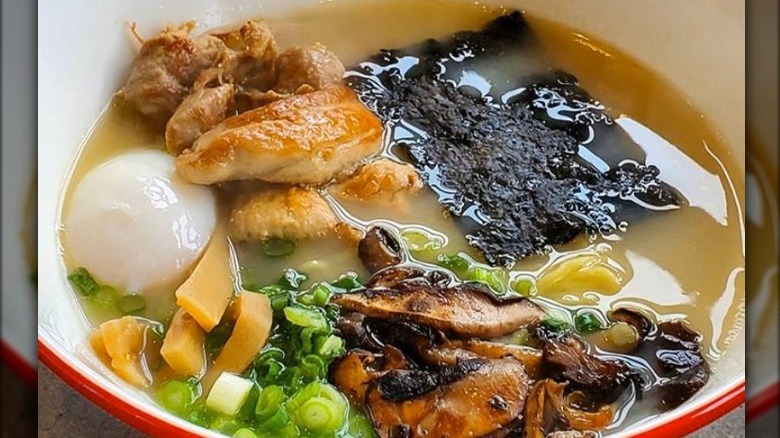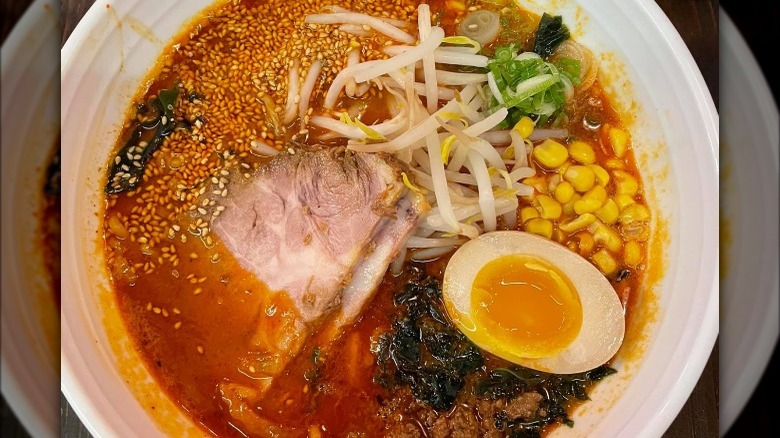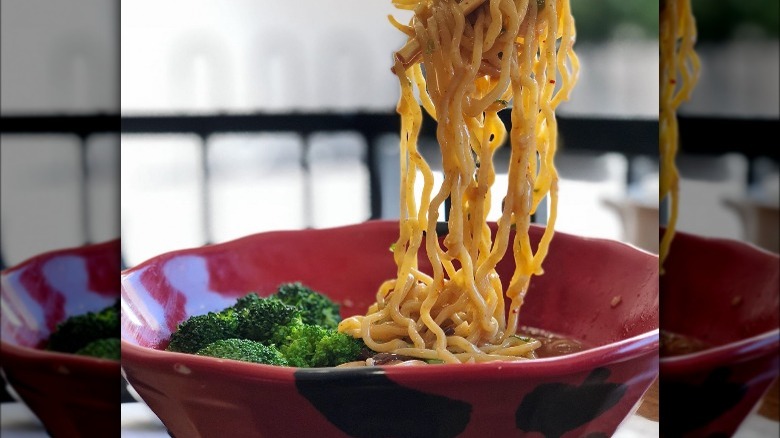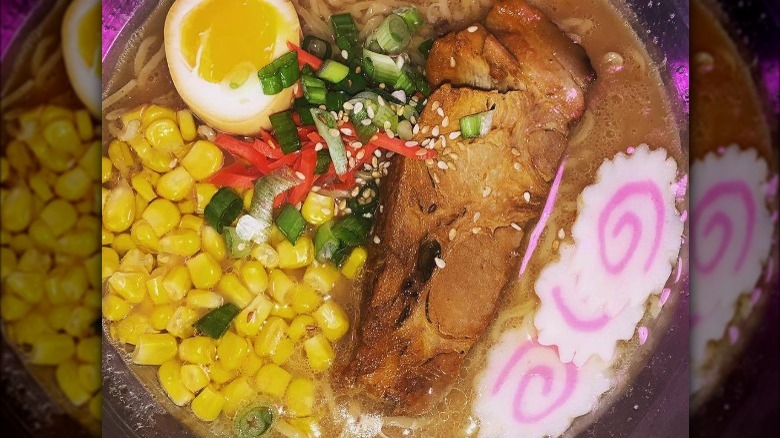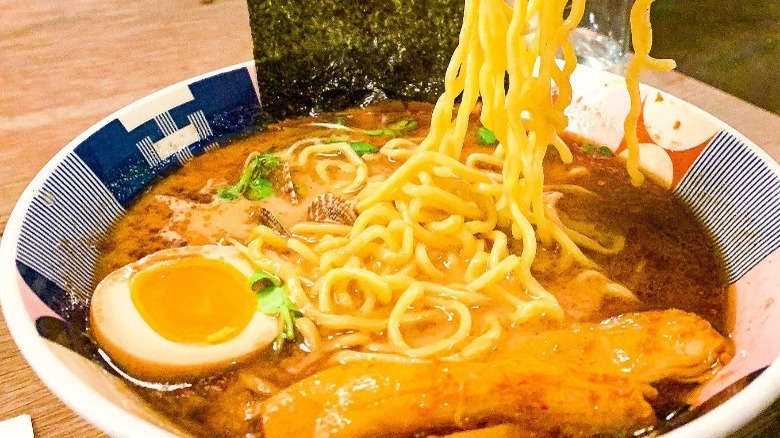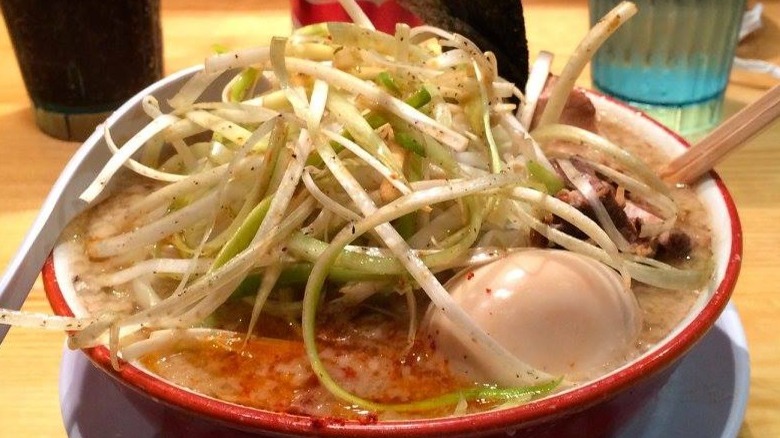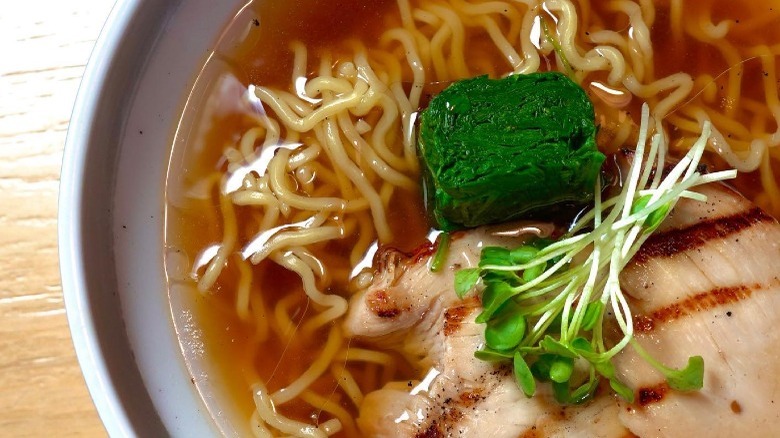The Absolute Best Ramen In The US
For many years in America, the Japanese tradition of ramen was reduced to a commoditized package of cheaply made noodles sold at an even cheaper price. The flavors were extremely salty and in some cases, downright offensive (Oriental flavor? Really?). Most consumers merely saw the food as a survival meal for broke college students. A lot has changed in the decades since instant noodles made it to the States. As Pete Wells writes for The New York Times, American eaters have developed an insatiable appetite for international foods, and that has driven a once disregarded style of soup into a gourmet revolution. Forget the foil seasoning packets: High-quality noodles take time, but they are here to stay. And the best ramen makers in the U.S. are getting comfortable with that.
There are just as many varieties of ramen as there are cities in Japan, each region offering a fresh taste and perspective on the combination of noodles, broth, and protein. Prepared in such an abundance of styles, this diversified dish offers something different for every eater, and each chef has a unique process for how they arrive at their final product. Some import noodles from the most revered artisans in Japan, others spend multiple days making their broth. The best way to honor the prismatic nature of authentic Japanese ramen? Eat as much of it as you can. Use this list of the absolute best ramen spots in America as a starting point.
Mr. Taka - New York City
The story of New York City's Mr. Taka began in a similar way to many of the ramen shops on this list. Successful Japanese-based ramen joints are eager to bring their creations to an American population hungry to eat them. Some of these transnational moves are made as chain establishments look for a new market, but Mr. Taka is one of a kind. The NYC restaurant was developed by longtime friends chef Takatoshi Nagara and writer Takayuki Watanabe. In Tokyo, Takatoshi ran Bigiya, one of the first ramen restaurants in the city to ever receive a Michelin Star.
Michelin Stars may not follow a chef from restaurant to restaurant, but the chef's skills and talents definitely do. Lines regularly form around the block for Mr. Taka's ramen, per Thrillist. A full menu of spicy ramen options awaits, including a soy milk-based vegan twist on a traditionally meat-heavy dish. Still, the biggest draw is the pork bone broth, buttery and rich after a 12-hour simmer. There is also a chicken and bonito fish broth, and across the various bowls, diners have the option of thin noodles or wide and wavy ones. This is a ramen playground.
Tatsunoya - Los Angeles
For every one person in Los Angeles, there is a ramen shop to feed them. That might be an exaggeration, but the City of Angels can feel like the City of Noodles sometimes, with a prolific collection of ramen houses that sprawl in character with L.A.'s (lack of) urban design. Fortunately, the vast Japanese food scene here has created a breeding ground for some of the best ramen in the country. Tatsunoya is one of those noodle houses, first opening in '99 in the Japanese city of Kurume. The restaurant is guided by the principle of kando, which describes an awe-inspiring feeling that it aims to instill in guests.
According to Tatsunoya, Kurume City, Fukuoka is the birthplace of tonkotsu ramen, the buttery, pork-based variety you've come to crave. The broth at this L.A. shop is simmered for 15 hours at a high temperature, extracting maximum umami and creating a light yet rich soup. In an interesting fashion, the ramen noodles are made by a local artisan crafter who uses Tatsunoya's honed recipe. This community approach extends to the menu, which offers three varieties of broth: koku (rich), jun (light), and spicy. It may be a congregation of options, but you won't want to share this bowl with anyone else.
Marafuku - San Francisco
Looking beyond the cultural food hubs of L.A. and NYC, excited noodle slurpers will find that San Francisco has long made a name for itself as a ramen capital of the U.S. Over the years, some of those foundational shops like Marafuku, have moved beyond the Bay City. Marafuku locations can now be found all over the map; there's one in NYC, Texas, and a few in SoCal. But with locations in San Fran proper, Oakland, and Redwood City, one of America's best ramen joints still makes time to call home.
At Marafuku, the ramen is an authentic variety of Hakata-style tonkotsu. The broth is a concoction of long-simmered pork bones, which cook for a total of 20 hours, as reported by Irvine Weekly. This develops into a fattier, milky broth filled with bubbles of flavor. Bathed in this creamy broth are ultra-thin noodles and melty slices of cha-shu, a style of specially-prepared pork belly. A large cast of accompanying ingredients appears across the menu, including kikurage mushrooms, crinkly flakes of nori, and seasoned soft-boiled eggs. Another unique variety of ramen is the TanTan Men, a ground chicken-loaded bowl of spicy goodness.
Ramen Wasabi - Chicago
Chicago is not just the Windy City, it is a frigid one as well. Few activities can warm up the stomach and soul like slurping a decadent bowl of noodles. Because of this comforting nature, (and other obviously delicious reasons), ramen shops are plentiful in Chicago, and Wasabi sits at the top of them. In fact, it serves some of the best ramen in the country, and as written in The Chicago Tribune, many consider it the "king of noodle soups." When chef Satoko Takeyama first opened her shop, her original focus was on sushi. Fortunately for tonkotsu pilgrims everywhere, there was a quick change of heart and menu.
When it comes to time-consuming broth making, Wasabi is unmatched. Their broth can cook for up to 45 hours, a multiday process that breaks down crucial collagen stores within heritage-breed Berkshire pork bones. This humanely-raised, primo-quality pork can be found all over Wasabi's menu; there's lush Berkshire pork belly in the Spicy Roasted Garlic Miso and Berkshire char-sui in the Hakata Red (a tingling bowl seasoned with numbing spices). Pork isn't the only item that is crave-worthy. A Vegan Tan Tan Men bowl is filled with a mushroom seaweed broth and studded by seitan ragu.
Uncle Ramen - Denver
As a part of the family unit, uncles have a sort of ... specific reputation. For better or worse, they are often considered the jokers, the agents of chaos who drop opinion bombs and then leave before it hits the fan. They can give good advice, serve as guides, and just generally be the fun, albeit, incautious member of the group. In a way, Uncle Ramen embodies these characteristics.
The flagship ramen is an alternative to the creamy tonkotsu — spicy chicken with sesame broth. They also serve Mazemen, a ramen bowl sans broth that puts a heavy focus on high-quality noodles. You'll only find two ramens that feature pork belly because duck confit and king trumpet mushrooms serve as surrogate proteins. These choices have turned Denver's most prominent ramen shop into the cool uncle and a highly beloved casual member of the Mile High City's food family.
According to The Denver Post, Uncle Ramen is such a cult classic that owner Tommy Lee had to open a second location to meet demand. And yet, lines still extend down the street, full of excited eaters waiting patiently to get a taste of this nationally renowned restaurant. Along with the spicy chicken, there are lighter chicken broths in Tokyo-style as well as a yellow curry vegetarian ramen. If you're up for the challenge, Uncle Ramen dares you to add the Spicy Bomb of miso pepper paste to your bowl. Come on, it'll be fun.
Daikaya - Washington, D.C.
More than almost any place in the country, the District of Columbia is an international town. Diplomats (and the industries that rise to make them feel at home) abound throughout the city limits, and tourists visit from the world over. All things considered, Washington, D.C.'s market for multinational food is broad, and ramen is a popular piece. Since 2013, Daikaya has been satisfying the craving. The two-story restaurant doubles as an Izakaya, but it is the first-floor noodle house that we're here for. Just like the political scene in this city, it's competitive, and a spot at the ramen shop goes on a first-come, first-served basis.
Daikaya's noodles are authentic but they aren't a house product. Instead, they arrive imported from the Nishiyama Seimen Company so that the restaurant can serve authentic Sapporo-style ramen (per Eater). This genre of noodle soup focuses on a miso broth and wavier noodles that have a chewy bounce to them Sapporo Travel writes. This gives Daikaya's main ramens less of a milky mouthfeel and instead, provides an aromatic slurp from start to finish. Dedicated pursuit of mastering this variety means that Daikaya serves some of the best bowls of ramen in the country.
Ramen Danbo - Various locations
Ramen Danbo is a chain of ramen shops that began in Japan before expanding to the Pacific Northwest via an establishment in Vancouver. Their soup is of such high quality that Danbo numbers over 20 locations in Japan, and since its arrival in North America, the noodle game here has never been the same. Ramen Danbo specializes in the regional Fukuoka-style, which is a derivative of the Hakata tonkotsu, but an original flavor in its own right. Danbo uses a Kyushu ramen noodle which is narrow, thin, and artisanally crafted. Creativity can be tasted in every bowl.
The piping hot bowls start with a ramen-dare base imported from Danbo's Japanese kitchens. It is a concentrate low in sodium but high in richness, combined with a pork broth made from specially treated spring water. The bowls preferred by Danbo regulars come topped with a spicy tare paste, a crucial step that packs in balanced heat. For even more spice, the Rekka ramen is the right move, and each soup from the tonkotsu to miso or sesame broth can be made in this fashion.
AFURI - Portland, Oregon
If ramen is a work of art then the ingredients are the paint. Thanks to a high level of access to fresh clean spring water, the Pacific Northwest is a special place for ramen. Some of Japan's most honored noodle houses have specifically chosen cities like Seattle and Portland because of their proximity to this resource. In the case of AFURI, the molecular similarities of Portland's aqua supply with their own water in Japan made it the ideal location to open shop in the U.S. AFURI's marketing director Yoshi Mecklenberg tells KOIN 6 Portland, "It allows us to replicate the same taste of the ramen we serve in Tokyo."
If the minds behind AFURI can be considered artists, then the menu makes them the eccentric type. Yes, there is the pork tonkotsu ramen that we all know and love, but there are also some wild and eclectic offerings. The vegetarian Tan Tan Men uses hazelnut broth and miso cashew crumbles, two Yuzu ramens feature chicken broth, and the Asari Shoyu consists of clam broth and truffle paste. These inventive flavors do more than work, they flex. AFURI's noodles should hang in a gallery, only the gallery is your mouth, and it's actually a whole museum erected just to exhibit the masterpiece of this ramen.
Ramen Tatsu-ya - Austin
Another titan of the noodle community is Austin-based Ramen Tatsu-ya. The name is a clever collaboration of the two owners, Tatsu Aikawa, and Takuya Matsumoto, but that isn't the only creative aspect here. Both Tatsu and Takuya were DJs in the Austin music scene at the same time as they were sharpening their culinary skills. So, one might say that the sound of healthy slurping at Tatsu-ya is music to their ears. More than that, slurping is considered to be one of the six rules of ramen eating at Tatsu-ya. They declare that it helps aerate the broth and enhance noodle flavor, but everyone knows that DJs like to hear noise from the crowd.
If there is anyone who knows about flavor, it is co-executive chef Tastu, who formerly worked at L.A.'s two Michelin starred sushi restaurant Urasawa. After his experience there, Tatsu joined with Takuya to share their excellent ramen with the world. There's no pretension here; ramen is Japanese soul food, and Tatsu-ya serves it as such.
From a traditional Tokyo-styled Ol' Skool (chicken shoyu broth) to original tonkotsu with cha-su and woodear mushrooms, the flavors kick like a snare drum. For something especially unique, try the Tsukemen, a dish of condensed pork broth served with noodles and toppings on the side. It's made to be dipped, and a bite of it is sure to make you dive and shimmy like you're on the dance floor.
Johnny Noodle King - Detroit
Detroit is rarely recognized among the great food cities of the U.S. This feels like an oversight, particularly when considering the impact that the Motor City has had on the history of pizza alone. When it comes to American traditions and foreign specialties, great restaurants can be found all over Detroit whether they're acknowledged as world-class locales or not. Johnny Noodle King is an example of how quality eats can transcend it all. In a city that thrives on comfort food and a low profile, this noodle shop puts Detroit on the map as one of the best ramen towns around.
This may not be one of the most traditional ramen experiences you've ever had, but there is beauty in that too. The Seafood Tom Kha floats ramen noodles, shrimp, and octopus in a coconut and chicken broth base. New Seoul brings an innovative Korean chili broth to pair with a kitchen sink kimchi. Detroit is big on ribs, and the Smoked Butter Noodles bring it all home. The flavors may be uncommon, but Johnny King relies on a regular pro for its noodles. They arrive custom-made straight from Sun Noodle Company, a Japanese craft producer based in Hawaii since 1981 (per Metro Times).
Ganko Ittestu Ramen - Boston
Detroit may not get the lion's share of recognition it deserves, but Boston doesn't have the same issue. Some of the nation's top-rated restaurants can be found here, and in particular, delicacies from all over the world thrive around town. Along with sushi giants like O-Ya, Ganko Ittestsu Ramen is an important character in the story of Japanese cuisine's success in Boston. But this tale actually started long ago. Ganko's noodles are sourced directly from Nishiyama Noodles, a Japanese company that has been crafting them since 1953. After receiving the noodles, Ganko Ittestu Ramen cures them to ensure a signature "elasticity and glossiness" is brought out, producing a bouncy, chewy result.
From there, Ganko travels even further back in time. The soy sauce that makes up the Kaeshi (soup base) at this restaurant has been carefully curated from a selection of brews produced by the 148-year-old Shoda Shoyu Company. Once it comes together with a Berkshire black pork and chicken stock (each prepped individually and then combined), Ganko Ittestu's ramen is nearly unmatched. A wide variety of bowl options can be found on the menu, each one cooked with extreme patience and attention to detail. The result, as reporter Devra First writes for The Boston Globe, is a bowl of food that can take you back in time while fully immersing you in the current experience of having just tasted something incredible.
Jinya Ramen Bar - Various locations
Of the ramen restaurants included on this list, some are independent noodle houses and some are the U.S. outposts of popular Japanese chains. Even among that latter category, most of the multiple-location ramen shops are one of a handful. A number of them are the only American location of their Japanese parent company. As a highly franchised chain with upwards of 40 locations, Jinya Ramen Bar is a world apart from these types of places (per Forbes). Fortunately, quantity does not translate to a loss in quality.
If you can find a Jinya Ramen Bar anywhere close to you, get there now. The silky tonkotsu at the heart of this modernized ramen shop is as good as one can hope for when looking to get a noodle fix. And it is accessible: Jinya remains open until 2 a.m. in some locales. Another exciting element about Jinya's milky broth is that it can be paired with different varieties of ramen, including two types of wonton soup that replace the crinkly gold noodles for something more akin to a filled dumpling. Founded on principles of good, inexpensive,and readily available food, that is exactly what you'll find at Jinya Ramen Bar.
Nomiya - New Orleans
In Japan, ramen is given a certain level of ceremony in regards to the process and ingredients it takes to put it all together. However, eating it is still often a casual experience, done standing up at a bar or in a quick-service fashion. This can be at odds with the pomp, fanfare, and expense that gourmet restaurants roll out for unique or foreign foods. Nomiya is a noodle house that delivers high-caliber ramen in a relaxed setting. The restaurant is so small that you're likely to pass it if you didn't know it was there on New Orleans' Magazine Street. Before the COVID-19 pandemic, guests often sat close enough that their dinner selections were based on inspiration from the bowls on the table next to them.
It's a choose your own adventure sort of place, and each decision ends in buttery rich noodle-slurping joy. You just have to be careful not to splash your neighbor. The menu at Nomiya is small, the narrow seating is walk-in only, and there's no carryout or delivery (per River Beats New Orleans). That exclusiveness is worth every drop of juice, especially in a bowl of the Kuro, a garlic oil and leek ramen with umami-bursting pickled ginger. The tonkotsu is a classic, and the Too Spicy label is exactly that, unless you're into the tongue-numbing style of soup. The best ramen has soul, and just like everything in the Big Easy, Nomiya dances all over your tastebuds.
Tonchin - New York City
Like many noodle shops, the team at Tonchin uses a specific Japanese word as a guiding philosophy for their ramen mission. Here, the word is dekitate and according to Tonchin's website, it means made for you. This goes deeper than just having handcrafted broth or housemade noodles. Dekitate implies it has just been made, and so everything at Tonchin is kept to the freshest standards possible, writes The New York Times. But this isn't a newly crafted venture; chef Anan Sugeno opened Tonchin in NYC as a spinoff from his father Katsuhiro Sugeno's Tokyo restaurant, open since '92.
The tables at Tonchin are filled with previously discussed varieties of ramen like Spicy Tan Tan and classic Tokyo tonkotsu, but they also feature house specialties like a Smoked Dashi ramen. Every bowl arrives as a pristinely created soup sloshing with flavor, accompanied by different styles of ramen noodles. You can't go wrong, be it with the brothless Mazemen with slow-roasted chicken or kinoko mushrooms, or Tsukemen dipping noodles filled with cha-su pork or spicy ground beef, marinated egg, and seaweed. Tonchin promises an establishment where guests can connect with love, and there's no doubt that eating at the restaurant inspires a passionate connection between chopsticks and chompers.
Tsujita - Los Angeles
Tsujita categorizes itself as artisan noodles. Chef Takehiro Tsujita doubled down on that with his first Los Angeles shop by going big on the style of Tsukemen ramen, where the noodles are served separately alongside a thickly condensed broth. The variety is made for dipping, and Los Angelenos have been slurping it down for years now. The heat of popularity has simmered up so much success for Tsujita that he now has four restaurant businesses on one L.A. street of Sawtelle Japantown (per Oishii-desu).
The pork bones of the Hakata-style tonkotsu at Tsujita are simmered for up to 60 hours, which sets the broth at an even longer cook time than Wasabi Ramen in Chicago. The result is heavenly as the condensed broth becomes silken, creating a fatty coat of decadent flavor that only noodles can sop up. Tsujita's quality is so sharp that it might very well be the best ramen in the country.
Ichigo Ramen Lounge - Dallas
Dallas is currently going through a food culture Renaissance, and luckily, dishes like ramen are helping guide the growth in new directions. Ichigo Ramen Lounge makes a case for being one of the best ramens in the States thanks to the supreme depth of flavor that can be tasted in each bowl. Sapporo-sourced noodles match thoughtfully crafted styles of broth, like the clear-shoyu Chintan which is a lighter option compared to tonkotsu. A chicken Paitan broth meets in the middle of the two, slightly milky but not so rich (per Serious Eats). Then there is the apple and fennel Shio, one of the earthier and sweeter vegetarian ramen styles from any menu.
Ichiguro is the loving project of the late chef George Itoh, who passed in the spring of 2021. The shop is now helmed by his wife Mei and daughters, Emma and Reiya (per Dallas Magazine). The family has carried on managing what is known as a genuine gem of the ramen world. Itoh's impact on this art will live on in the food that emerges from the kitchens at Ichigo and in all the ramen chefs and eaters those meals will continue to inspire.
